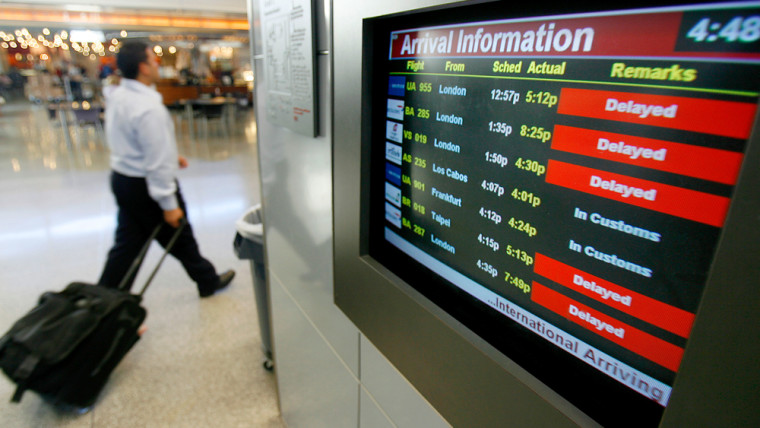Rather than blow up airliners in midair, the suspected terrorists arrested Thursday in Great Britain likely hoped to create smaller explosions that would breach the hulls of the planes and send them into long, terrifying crashes, heightening the psychological impact on the public, U.S. officials and terrorism analysts said.
British police arrested 24 people who they said planned to simultaneously blow up several aircraft heading to the United States using explosives smuggled in carry-on luggage. The alleged plot suggests that the suspects knew they could not create an explosive large enough to destroy an airliner immediately, the analysts said.
However, the plotters would have been able to smuggle aboard small quantities that, alone or in combination, could blast a hole in an airplane far enough out over the Atlantic Ocean that its pilot could not return safely to land.
“This means that they think that whatever they did would not be catastrophic to the aircraft immediately,” said retired Army Col. Jack Jacobs, a former instructor at the U.S. Military Academy and a military analyst for MSNBC.
Instead, as the world watched, the planes would crash into the ocean, killing anyone on board who had not already been incinerated as the aircraft burned.
“The idea of multiple explosions on multiple airplanes is designed to strike fear not only into those who are flying that day, but to the whole worldwide aviation system,” said Michael Chertoff, the secretary of homeland security.
“And that is really the point,” Chertoff said on MSNBC TV’s “Hardball.” “These kinds of big terror plots are not merely about killing innocent people, although that is bad enough; but it’s about striking at the foundations of our Western society. Travel, tourism, trade, that's what binds the world together, that’s what promotes peace. And these people want to destroy those bonds.”
Common household items
Experts said that with the appropriate training, even an unsophisticated terrorist could destroy an airliner with an explosive concealed in a few dollars’ worth of ordinary products sold at every grocery and drug store. More sophisticated terrorists could even make the explosives themselves from those products, including nail polish remover.
Such components are unnervingly difficult for security officers to detect, Chertoff said.
“Now, it is one thing if someone comes in with an obvious bottle of some liquid with duct tape and wires sticking out of it,” he said, “but when someone separates the bomb into components, and each of the components is benign and appears to be very similar to an ordinary beverage someone might bring on an airplane, then you are really dealing with a very sophisticated challenge.”
Another MSNBC military analyst, Rick Francona, a retired Air Force lieutenant colonel, said there are “several different liquids that you can use to make a bomb on board an aircraft that would not be detectable by any of the current methods that they’re using.”
Possible explosives would most likely take the form of a powder or a gel that would be easy to mistake for a variety of common household and grooming products, most notably shampoo, hair styling gel, talcum powder and baby formula.
The information known so far indicates a plot similar to the one that ended in the destruction of Pan American Flight 103 over Lockerbie, Scotland, in 1988, killing 270 people. In that attack, which was blamed on Libya, conspirators managed to bring down the Boeing 747 with less than a pound of explosive materials.
“When you’re dealing with an aircraft flying at high altitude in a pressurized environment, you don’t need a whole lot of explosives to bring a plane down,” said Francona, who founded the Defense Department’s counterterrorism intelligence branch. “In fact ... two or three people could easily bring enough of this material to make a device that could cripple an aircraft.”
Two explosives speculated
Authorities would not describe the materials the suspects intended to use, but analysts said the Transportation Security Administration’s immediate ban on common consumer products from air passengers’ carry-on bags suggested two leading candidates.
One is triacetone triperoxide, or TATP, which can be made by combining two common products sold in every drugstore. Richard Reid was convicted of attempting to blow up an American Airlines flight in 2001 using TATP concealed in his shoes.
They said the other is potassium chlorate, which can be made by chemically treating laundry bleach with heat and other common materials. It creates a gel that looks similar to many hair styling gels and some toothpastes.
John Pike, director of GlobalSecurity.org, said other, more sophisticated explosives were possible, including astrolite, a liquid explosive invented in the 1960s, and dual-component compounds that are commercially available for clearing minefields.
Noting reports that several of the British suspects had traveled to Pakistan, Pike said even unsophisticated operatives could be trained in handling and secreting the materials by scientists in Pakistan’s defense industry, which is known to have experimented with small, hard-to-detect explosives.
“If you know what you’re doing — if you’re, say, an explosives chemist from Pakistan’s defense industry — this is something they would know how to fabricate,” said Pike, formerly a military and intelligence specialist with the Federation of American Scientists. “They would be able to teach this art to someone else.
“It’s cookbook chemistry,” he added on MSNBC TV’s “The Most.” “The big challenge, of course, is being sure that you’ve got a good cookbook.”
Nitroglycerin unlikely
Experts all but ruled out the use of more widely known explosives suggested in early reports, notably nitroglycerin.
Nitroglycerin is so powerful that an amount sufficient to bring down an airliner could be concealed in a single contact lens case, making it an attractive prospect for a potential suicide bomber. But it is also extremely volatile — a single vigorous shake can set it off.
Nitroglycerin “could explode at any second, so there would be no possible way” a terrorist could be confident that he could “even get on the aircraft with this stuff,” Jacobs said.
